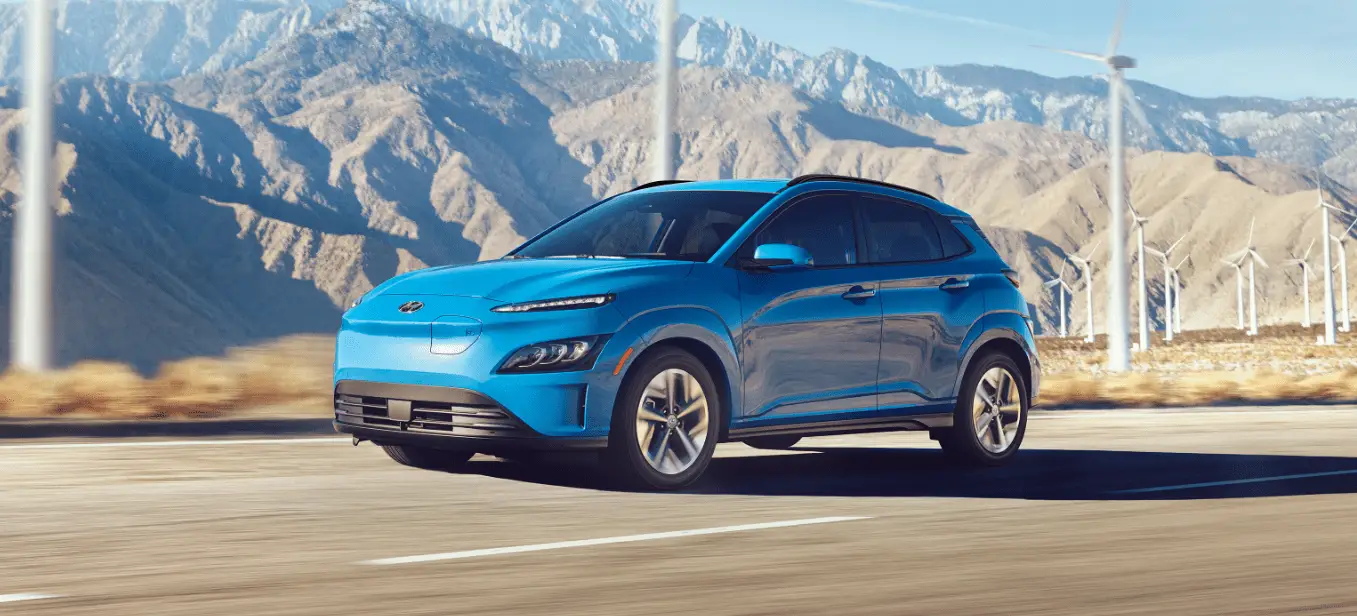Hyundai Kona-EV 2023 Navigation-Based Smart Cruise Control (NSCC)
In the 2023 Hyundai Kona-EV, a new Navigation-Based Smart Cruise Control system is added. This system uses cutting-edge GPS and map data technology to completely change the way you drive. This more advanced driver assistance feature goes beyond basic adaptive cruise control by using real-time road and traffic data to intelligently change the vehicle’s speed as it approaches curves, intersections, changes in speed limits, and changing traffic conditions. By adjusting the speed of the car to match the speed of the road ahead, it improves safety, comfort, and gas mileage while reducing the need for constant manual intervention. In addition, the 2023 Kona-EV has a Lane Following System with camera and sensor technology to help keep the car exactly in its lane by giving the driver subtle steering assistance when the car accidentally leaves its lane. This system works with Navigation-Based Smart Cruise Control to provide a complete and reassuring driving experience while stressing that the driver’s active participation is still an important part of safe operation.
2023 Hyundai Santa Fe Specs, Price, Features, Milage (Brochure)
Navigation-Based Smart Cruise Control Operation
Operating conditions
Navigation-based Smart Cruise Control is ready to operate if all of the following conditions are satisfied:
- Smart Cruise Control is operating
- Driving on main roads of highways (or motorways)
Information
For more details on how to operate Smart Cruise Control, refer to the “Smart Cruise Control (SCC)” section in this chapter.
Navigation-based Smart Cruise Control display and control
When Navigation-based Smart Cruise Control operates, it will be displayed on the cluster as follows:
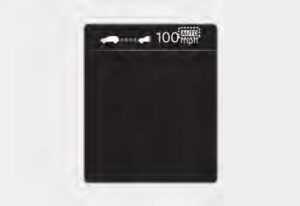
Navigation-based Smart Cruise Control standby
If the operating conditions are satisfied, the white indicator will illuminate.

Navigation-based Smart Cruise Control operating
If temporary deceleration is required in the standby state and Navigation-based Smart Cruise Control is operating, the green symbol will illuminate on the cluster.
If the Highway Set Speed Auto Change function operates, the symbol and set speed will illuminate in green on the cluster, and an audible warning will sound.
warning

‘Drive carefully’ warning message will appear in the following circumstances:
Navigation-based Smart Cruise Control is not able to slow down your vehicle to a safe speed
Information
The Highway Curve Zone Auto Slowdown and Highway Set Speed Auto Change function uses the same symbol.
Highway Curve Zone Auto Slowdown
- Depending on the curve ahead on the highway (or motorway), the vehicle will decelerate, and after passing the curve, the vehicle will accelerate to Smart Cruise Control set speed.
- Vehicle deceleration time may differ depending on the vehicle speed and the degree of the curve on the road. The higher the driving speed, deceleration will start faster.
Highway Set Speed Auto Change
- The Highway Set Speed Auto Change function will operate when Smart Cruise Control set speed and the highway (or motorway) speed limit is matched.
- While Highway Set Speed Auto Change function is operating, when the highway (or motorway), speed limit changes, Smart Cruise Control set speed automatically changes to the changed speed limit.
- If the Smart Cruise Control set speed is adjusted differently from the speed limit, the Highway Set Speed Auto Change function will be in the standby state.
- If the Highway Set Speed Auto Change function has changed to the standby state by driving on a road other than the highway (or motorway) main road, Highway Set Speed Auto Change function will operate again when you drive on the main road again without setting the set speed.
- If the Highway Set Speed Auto Change function has changed to the standby state by depressing the brake pedal or pressing the switch on the steering wheel, press the switch to restart the function.
- The Highway Set Speed Auto Change function does not operate on highway interchanges or junctions.
Information
- The Highway Set Speed Auto Change function only operates based on the speed limits of the highway (or motorway), it does not work with the speed cameras.
- When the Highway Set Speed Auto Change function is operating, the vehicle automatically accelerates or decelerates when the highway (or motorway) speed limit changes.
- The maximum set speed for the Highway Set Speed Auto Change function is 81 mph (130 km/h).
- If the speed limit of a new road is not updated in the navigation, the Highway Set Speed Auto Change function may not operate properly.
- If the speed unit is set to a unit other than the speed unit used in your country, the Highway Set Speed Auto Change function may not operate properly.
Limitations of Navigation-Based Smart Cruise Control
Navigation-based Smart Cruise Control may not operate normally under the following circumstances:
- The navigation is not working properly
- Map information is not transmitted due to the infotainment system’s abnormal operation
- Speed limit and road information in the navigation is not updated
- The map information and the actual road is different because of real-time GPS data or map information error
- The navigation searches for a route while driving
- GPS signals are blocked in areas such as tunnel
- A road that divides into two or more roads and joins again
- The driver goes off course the route set in the navigation
- The route to the destination is changed or cancelled by resetting the navigation
- The vehicle enters a service station or rest area
- Android Auto or Car Play is operating
- The navigation cannot detect the current vehicle position (for example, elevated roads including overpasses adjacent to general roads or nearby roads exist in a parallel way)
- The navigation is being updated while driving
- The navigation is being restarted while driving
- The speed limit of some sections changes according to the road situations
- Driving on a road under construction
- Driving on a road that is controlled
- There is bad weather, such as heavy rain, heavy snow, etc.
- Driving on a sharply curved road
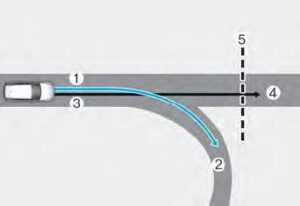
[1] : Set route, [2] : Branch line, [3] : Driving route, [4] : Main road, [5] : Curved road section
- When there is a difference between the navigation set route (branch line) and the driving route (main road), Highway Curve Zone Auto Slowdown function may not operate until the driving route is recognized as the main road.
- When the vehicle’s driving route is recognized as the main road by maintaining the main road instead of the navigation set route, Highway Curve Zone Auto Slowdown function will operate. Depending on the distance to the curve and the current vehicle speed, vehicle deceleration may not be sufficient or may decelerate rapidly.

[1] : Set route, [2] : Branch line, [3] : Driving route, [4] : Main road, [5] : Curved road section
- When there is a difference between the navigation route (main road) and the driving route (branch line), the Highway Curve Zone Auto Slowdown function will operate based on the curve information on the main road.
- When it is judged that you are driving out of the route by entering the highway interchange or junction, the Highway Curve Zone Auto Slowdown function will not operate.

[1] : Driving route, [2] : Branch line,
[3] : Curved road section, [4] : Main road
- If there is no destination set on the navigation, the Highway Curve Zone Auto Slowdown function will operate based on the curve information on the main road.
- Even if you depart from the main road, the Highway Curve Zone Auto Slowdown function may temporarily operate due to navigation information of the highway curve section.
WARNING
- Navigation-based Smart Cruise Control is not a substitute for safe driving practices, but a convenience function. Always have your eyes on the road, and it is the responsibility of the driver to avoid violating traffic laws.
- The navigation’s speed limit information may differ from the actual speed limit information on the road. It is the driver’s responsibility to check the speed limit on the actual driving road or lane.
- Navigation-based Smart Cruise Control will automatically be cancelled when you leave the highway (or motorway) main road. Always pay attention to road and driving conditions while driving.
- Navigation-based Smart Cruise Control may not operate due to the existence of leading vehicles and the driving conditions of the vehicle. Always pay attention to road and driving conditions while driving.
- When you are towing a trailer or another vehicle, turn off Navigation-based Smart Cruise Control for safety reasons.
- After you pass through a tollgate on a highway (or motorway), Navigation-based Smart Cruise Control will operate based on the first lane. If you enter one of the other lanes, the function might not operate properly.
- The vehicle will accelerate if the driver depresses the accelerator pedal while Navigation-based Smart Cruise Control is operating, and the function will not decelerate the vehicle. However, if the accelerator pedal is depressed insufficiently, the vehicle may decelerate.
- If the driver accelerates and releases the accelerator pedal while Navigation-based Smart Cruise Control is operating, the vehicle may not decelerate sufficiently or may rapidly decelerate to a safe speed.
- If the curve is too large or too small, Navigation-based Smart Cruise Control may not operate.
Information
- A time gap could occur between the navigation’s guidance and when the Navigation-based Smart Cruise Control operation starts and ends.
- The speed information on the cluster
and navigation may differ. - Even if you are driving at a speed lower than Smart Cruise Control’s set speed, acceleration may be limited by the curve sections ahead.
- If Navigation-based Smart Cruise Control is operating while leaving the main road to enter an interchange, junction, rest area, etc., the function may operate for a certain period of time.
- Deceleration by Navigation-based Smart Cruise Control may feel it is not sufficient due to road conditions such as uneven road surfaces, narrow lanes, etc.
Information
This device complies with Part 15 of the FCC rules.
Operation is subject to the following three conditions:
- This device may not cause harmful interference, and
- This device must accept any interference received, including interference that may cause undesired operation.
- Changes or modifications not expressly approved by the party responsible for compliance could void the user’s authority to operate the device.
Information
Radiofrequency radiation exposure information:
This equipment complies with FCC radiation exposure limits set forth for an uncontrolled environment.
This equipment should be installed and operated with a minimum distance of 8 in. (20 cm) between the radiator (antenna) and your body.
This transmitter must not be co-located or operating in conjunction with any other antenna or transmitter.
2023 Hyundai Santa Fe Specs, Price, Features, Milage (Brochure)
Lane Following Assist (LFA)
Lane Following Assist is designed to help detect lane markings and/or vehicles on the road and assist the driver steering to help keep the vehicle between lanes.
Detecting sensor

[1]: Front view camera
The front view camera is used as a detecting sensor to detect lane markings and front vehicles. Refer to the picture above for the detailed location of the detecting sensor.
CAUTION
For more details on the precautions of the front view camera, refer to the “Forward Collision-Avoidance Assist (FCA)” section in this chapter.
Lane Following Assist Settings
Setting features

Turning Lane Following Assist On/Off
With the vehicle on, press the Lane Driving Assist button located on the steering wheel to turn on Lane Following Assist. The white or green indicator light will illuminate on the cluster. Press the button again to turn off the function.
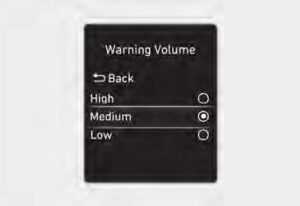
Warning Volume
With the vehicle on, select Driver Assistance> Warning volumne’ or “Sound Driver Assist Warning> Warning Volume’ from the Settings menu to change the Warning Volume to ‘High, Medium, or “Low’ for Hands-off warning. If you change the Warning Volume, the warning volume of other Driver Assistance systems may change.
Lane Following Assist Operation
Warning and control
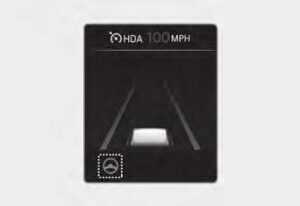
Lane Following Assist
If the vehicle ahead and/or both lane markings are detected and your vehicle speed is below 120 mph (200 km/h), the green indicator light will illuminate on the cluster, and Lane Following Assist will help the vehicle stay in lane by assisting the steering wheel.
CAUTION
When the steering wheel is not assisted, the white indicator light will blink and change to grey.
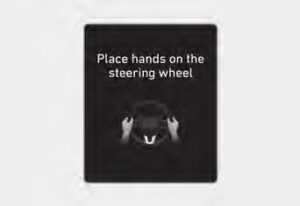
Hands-off warning
If the driver takes their hands off the steering wheel for several seconds, in stages warning message will appear and an audible warning will sound in stages.
First stage: Warning message
Second stage: Warning message (red steering wheel) and audible warning
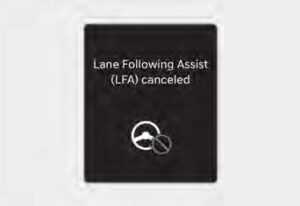
If the driver still does not have their hands on the steering wheel after the hands-off warning, the ‘Lane Following assist cancelled warning message will appear and Lane Following Assist will be automatically canceled.
WARNING
- The steering wheel may not be assisted if the steering wheel is held very tight or the steering wheel is steered over a certain degree.
- Lane Following Assist does not operate at all times. It is the responsibility of the driver to safely steer the vehicle and to maintain the vehicle in its lane.
- The hands-off warning message may appear late depending on road conditions. Always have your hands on the steering wheel while driving.
- If the steering wheel is held very lightly the hands–off warning message may appear because Lane Following Assist may not recognize that the driver has their hands on the steering wheel.
- If you attach objects to the steering wheel, the hands-off warning may not work properly.
Information
- For more details on setting the functions in the infotainment system, refer to “Vehicle Settings” section in Chapter 4.
- When both lane markings are detected, the lane lines on the cluster will change from grey to white.
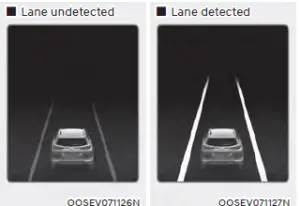
- If lane markings are not detected, steering wheel control by Lane Following Assist can be limited depending on whether a vehicle is in front or the driving conditions of the vehicle.
- Even though the steering is assisted by Lane Following Assist, the driver may control the steering wheel.
- The steering wheel may feel heavier or lighter when the steering wheel is assisted by Lane Following Assist than when it is not.
Lane Following Assist Malfunction and Limitations
Lane Following Assist malfunction
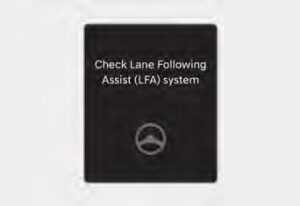
When Lane Following Assist is not working properly, the ‘Check Lane following assist system message will appear for several seconds, and the master ( ) warning light will illuminate on the cluster. If the master warning light illuminates, have the vehicle inspected by an authorized HYUNDAI dealer.
Limitations of Lane Following Assist
For more details on system limitations, refer to “Lane Keeping Assist (LKA)” section in this chapter.
WARNING
For more details on Lane Following Assist precautions, refer to “Lane Keeping Assist (LKA)” section in this chapter.
FAQ
Navigation-Based Smart Cruise Control, often abbreviated as SCC, is an advanced driver assistance system that utilizes GPS and map data to enhance traditional adaptive cruise control (ACC) functionality. It can adjust the vehicle’s speed based on the road and traffic conditions provided by the navigation system.
Navigation-based SCC uses GPS and map data to anticipate changes in road conditions, such as curves, intersections, and speed limits. It can then adjust the vehicle’s speed accordingly, providing a smoother and more efficient driving experience.
The benefits of Navigation-Based SCC include improved fuel efficiency, reduced driver fatigue, and a more comfortable driving experience. It can also enhance safety by ensuring that the vehicle adapts to the road and traffic conditions more effectively.
A Lane Following System, often referred to as LFS or Lane Keeping Assist, is a feature that helps a vehicle stay within its lane. It uses cameras and sensors to monitor lane markings and can make small steering adjustments to keep the vehicle centered in the lane.
A Lane Following System works by continuously analyzing the lane markings on the road. If it detects that the vehicle is drifting out of its lane without the driver using the turn signal, it can provide gentle steering inputs to keep the vehicle centered.
Navigation-based SCC and Lane Following Systems are often integrated into advanced driver assistance systems in modern vehicles. While they serve different purposes (speed control vs. lane keeping), they can work together to provide a more comprehensive driving experience.
Navigation-based SCC relies on GPS data to enhance its functionality, but it does not necessarily require constant GPS connectivity. The system may continue to operate based on the last known GPS data if the signal is temporarily lost.
Yes, drivers can usually override Navigation-Based SCC by taking control of the accelerator or brake pedals or by disengaging the system through the vehicle’s controls.
Navigation-Based SCC may have limitations in extreme weather conditions or in areas with poor GPS reception. It’s important for drivers to remain attentive and be prepared to take control of the vehicle when needed.
Some vehicle manufacturers offer software updates to improve the functionality of driver assistance systems, including Navigation-Based SCC. It’s possible that the 2023 Hyundai Kona-EV may receive such updates over time.
Navigation-Based SCC and Lane Following Systems are designed to enhance safety by reducing the driver’s workload and helping maintain proper speed and lane position. However, they are not a substitute for attentive driving, and the driver should always be prepared to take control of the vehicle.
The use of Navigation-Based SCC and Lane Following Systems may be subject to local laws and regulations. Drivers should familiarize themselves with the specific rules in their region and use these systems responsibly.
The availability and cost of Navigation-Based SCC and Lane Following Systems can vary depending on the vehicle and trim level. Some features may be included as standard, while others may require the purchase of optional packages or higher trim levels. It’s essential to review the vehicle’s specifications and pricing to determine any additional costs.
Useful Link
View Full User Guide: Hyundai Kona-EV 2023 User Guide
Download Manuals: https://owners.hyundaiusa.com/us/en/resources/manuals-warranties.html
2023 Hyundai Santa Fe Specs, Price, Features, Milage (Brochure)

